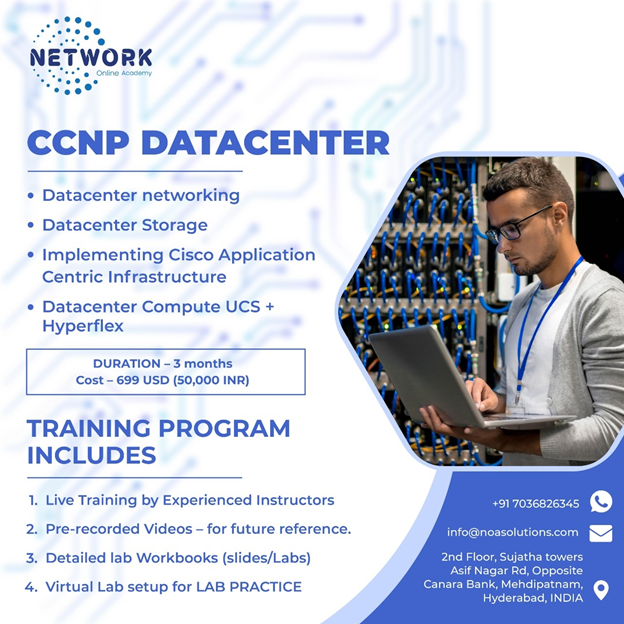Online Courses
- 1. Cisco Certified Network Associate - CCNA 200-301
- 2. CCNP ENTERPRISE – Core 350-401
- 3. CCNP ENTERPRISE – Advanced Routing 300-410
- 4. CCNP ENTERPRISE – SDWAN 300-415 – WAN Automation
- 5. SD-ACCESS – Cisco DNAC- LAN Automation
- 6. CCNP SECURITY - 350-701 Security Core
- 7. CCNP SECURITY - 300-730 Virtual Private Networks (VPN)
- 8. CCNP SECURITY - 300-710 Firepower + NGIPS
- 9. CCNP SECURITY – Web /Email Security (300-720/725)
- 10. CCNP SECURITY - 300-715 Identity Service Engine (ISE)
- 11. CCNP SERVICE PROVIDER – 350-501 Core
- 12. CCNP SERVICE PROVIDER – 350-510 Advanced Routing
- 13. CCNP SERVICE PROVIDER – 300-515 VPN Services
- 14. CCNP DATACENTER – 350-601 Core
- 15. CCNP DATACENTER – 300-620 ACI (Application Centric Infrastructure)
- 16. CCNP DATACENTER – Nexus
- 17. CCIE ENTPERISE INFRASTRUCTURE
- 18. CCIE Security
- 19. CCIE Service Provider
- 20. JNCIA - Enterprise Routing and Switching (JN0-102)
- 21. Cisco ASA firewall / Cisco Firepower-
- 22. Checkpoint Firewall (CCSA)
- 23. Fortigate Firewall (NSE 4-5 )
- 24. PaloAlto Firewall
- 25. F5 Load balancers – LTM
- 26. Python Programming – for Network Engineers
- 27. CCNA Devnet – 300-901
- 28. Cisco Ansible- Automating networks
- 29. Microsoft Certified Engineer ( MCSE 2016)
- 30. Vmware Vsphere 6.5
- 31. AWS Solutions Architect
- 32. Microsoft Azure Administrator

350-601 DCCOR
Implementing and Operating Cisco Data Center Core Technologies
Duration – 6 Weeks ( 120 hrs/day)
Price – 20,000 INR ( 300 USD )
DEMO VIDEO (YouTube links)
Training Program Includes
Contact us to reserve your slot for Online Trainings
For more Details Mail us on info@noasolutions.com
Faster communication – WhatsApp – +91 7036826345
Course Content
1.0 Network
1.1 Apply routing protocols
- 1.1.a OSPFv2, OSPFv3
- 1.1.b MP-BGP
- 1.1.c PIM
- 1.1.d FHRP
1.2 Apply switching protocols such as RSTP+, LACP and vPC
1.3 Apply overlay protocols such as VXLAN EVPN and OTV
1.4 Apply ACI concepts
- 1.4.a Fabric setup
- 1.4.b Access policies
- 1.4.c VMM
- 1.4.d Tenant policies
1.5 Analyze packet flow (unicast, multicast, and broadcast)
1.6 Analyze Cloud service and deployment models (NIST 800-145)
1.7 Describe software updates and their impacts
- 1.7.a Disruptive / nondisruptive
- 1.7.b EPLD
- 1.7.c Patches
1.8 Implement network configuration management
1.9 Implement infrastructure monitoring such as NetFlow and SPAN
1.10 Explain network assurance concepts such as streaming telemetry
2.0 Compute
2.1 Implement Cisco Unified Compute System Rack Servers
2.2 Implement Cisco Unified Compute System Blade Chassis
- 2.2.a Initial setup
- 2.2.b Infrastructure management
- 2.2.c Network management (VLANs, pools and policies, templates, QoS)
- 2.2.d Storage management (SAN connectivity, Fibre Channel zoning, VSANs, WWN pools, SAN policies, templates)
- 2.2.e Server management (Server pools and boot policies)
2.3 Explain HyperFlex Infrastructure Concepts and benefits (Edge and Hybrid Architecture vs all-flash)
2.4 Describe firmware and software updates and their impacts on B-Series and C-Series servers
2.5 Implement compute configuration management (Backup and restore)
2.6 Implement infrastructure monitoring such as SPAN and Intersight
3.0 Storage Network
3.1 Implement Fibre Channel
- 3.1.a Switch fabric initialization
- 3.1.b Port channels
- 3.1.c FCID
- 3.1.d CFS
- 3.1.e Zoning
- 3.1.f FCNS
- 3.1.g Device alias
- 3.1.h NPV and NPIV
- 3.1.i VSAN
3.2 Implement FCoE Unified Fabric (FIP and DCB)
3.3 Describe NFS and NAS concepts
3.4 Describe software updates and their impacts (Disruptive/nondisruptive and EPLD)
3.5 Implement infrastructure monitoring
4.0 Automation
4.1 Implement automation and scripting tools
- 4.1.a EEM
- 4.1.b Schedule
- 4.1.c Bash Shell and Guest Shell for NX-OS
- 4.1.d REST API
- 4.1.e JSON and XML encodings
4.2 Evaluate automation and orchestration technologies
- 4.2.a Ansible
- 4.2.b Puppet
- 4.2.c Python
- 4.2.d POAP
- 4.2.e DCNM
- 4.2.f UCSD
- 4.2.g PowerShell
5.0 Security
5.1 Apply network security
- 5.1.a AAA and RBAC
- 5.1.b ACI contracts and micro segmentation
- 5.1.c First-hop security features such as dynamic ARP inspection (DAI), DHCP snooping, and port security
- 5.1.d CoPP
5.2 Apply compute security
- 5.2.a AAA and RBAC
- 5.2.b Keychain authentication
5.3 Apply storage security
- 5.3.a AAA and RBAC
- 5.3.b Port security
- 5.3.c Fabric binding

